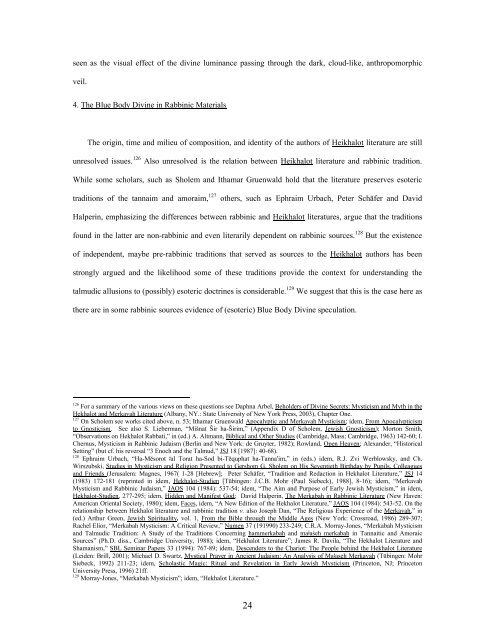Sapphiric God: - Dr. Wesley Muhammad
Sapphiric God: - Dr. Wesley Muhammad
Sapphiric God: - Dr. Wesley Muhammad
Create successful ePaper yourself
Turn your PDF publications into a flip-book with our unique Google optimized e-Paper software.
seen as the visual effect of the divine luminance passing through the dark, cloud-like, anthropomorphic<br />
veil.<br />
4. The Blue Body Divine in Rabbinic Materials<br />
The origin, time and milieu of composition, and identity of the authors of Heikhalot literature are still<br />
unresolved issues. 126 Also unresolved is the relation between Heikhalot literature and rabbinic tradition.<br />
While some scholars, such as Sholem and Ithamar Gruenwald hold that the literature preserves esoteric<br />
traditions of the tannaim and amoraim, 127 others, such as Ephraim Urbach, Peter Schäfer and David<br />
Halperin, emphasizing the differences between rabbinic and Heikhalot literatures, argue that the traditions<br />
found in the latter are non-rabbinic and even literarily dependent on rabbinic sources. 128 But the existence<br />
of independent, maybe pre-rabbinic traditions that served as sources to the Heikhalot authors has been<br />
strongly argued and the likelihood some of these traditions provide the context for understanding the<br />
talmudic allusions to (possibly) esoteric doctrines is considerable. 129 We suggest that this is the case here as<br />
there are in some rabbinic sources evidence of (esoteric) Blue Body Divine speculation.<br />
126 For a summary of the various views on these questions see Daphna Arbel, Beholders of Divine Secrets: Mysticism and Myth in the<br />
Hekhalot and Merkavah Literature (Albany, NY.: State University of New York Press, 2003), Chapter One.<br />
127 On Scholem see works cited above, n. 53; Ithamar Gruenwald Apocalyptic and Merkavah Mysticism; idem, From Apocalypticism<br />
to Gnosticism. See also S. Lieberman, “Mišnat Šir ha-Širim,” (Appendix D of Scholem, Jewish Gnosticism); Morton Smith,<br />
“Observations on Hekhalot Rabbati,” in (ed.) A. Altmann, Biblical and Other Studies (Cambridge, Mass; Cambridge, 1963) 142-60; I.<br />
Chernus, Mysticism in Rabbinic Judaism (Berlin and New York: de Gruyter, 1982); Rowland, Open Heaven; Alexander, “Historical<br />
Setting” (but cf. his reversal “3 Enoch and the Talmud,” JSJ 18 [1987]: 40-68).<br />
128 Ephraim Urbach, “Ha-Mĕsorot #al Torat ha-Sod bi-Tĕquphat ha-Tanna"im,” in (eds.) idem, R.J. Zvi Werblowsky, and Ch.<br />
Wirszubski, Studies in Mysticism and Religion Presented to Gershom G. Sholem on His Seventieth Birthday by Pupils, Colleagues<br />
and Friends (Jerusalem: Magnes, 1967( 1-28 [Hebrew]; Peter Schäfer, “Tradition and Redaction in Hekhalot Literature,” JSJ 14<br />
(1983) 172-181 (reprinted in idem, Hekhalot-Studien [Tübingen: J.C.B. Mohr (Paul Siebeck), 1988], 8-16); idem, “Merkavah<br />
Mysticism and Rabbinic Judaism,” JAOS 104 (1984): 537-54; idem, “The Aim and Purpose of Early Jewish Mysticism,” in idem,<br />
Hekhalot-Studien, 277-295; idem, Hidden and Manifest <strong>God</strong>; David Halperin, The Merkabah in Rabbinic Literature (New Haven:<br />
American Oriental Society, 1980); idem, Faces, idem, “A New Edition of the Hekhalot Literature,” JAOS 104 (1984): 543-52. On the<br />
relationship between Hekhalot literature and rabbinic tradition v. also Joseph Dan, “The Religious Experience of the Merkavah,” in<br />
(ed.) Arthur Green, Jewish Spirituality, vol. 1, From the Bible through the Middle Ages (New York: Crossroad, 1986) 289-307;<br />
Rachel Elior, “Merkabah Mysticism: A Critical Review,” Numen 37 (191990) 233-249; C.R.A. Morray-Jones, “Merkabah Mysticism<br />
and Talmudic Tradition: A Study of the Traditions Concerning hammerkabah and ma#aśeh merkabah in Tannaitic and Amoraic<br />
Sources” (Ph.D. diss., Cambridge University, 1988); idem, “Hekhalot Literature”; James R. Davila, “The Hekhalot Literature and<br />
Shamanism,” SBL Seminar Papers 33 (1994): 767-89; idem, Descenders to the Chariot: The People behind the Hekhalot Literature<br />
(Leiden: Brill, 2001); Michael D. Swartz, Mystical Prayer in Ancient Judaism: An Analysis of Ma#aseh Merkavah (Tübingen: Mohr<br />
Siebeck, 1992) 211-23; idem, Scholastic Magic: Ritual and Revelation in Early Jewish Mysticism (Princeton, NJ; Princeton<br />
University Press, 1996) 21ff.<br />
129 Morray-Jones, “Merkabah Mysticism”; idem, “Hekhalot Literature.”<br />
24
















